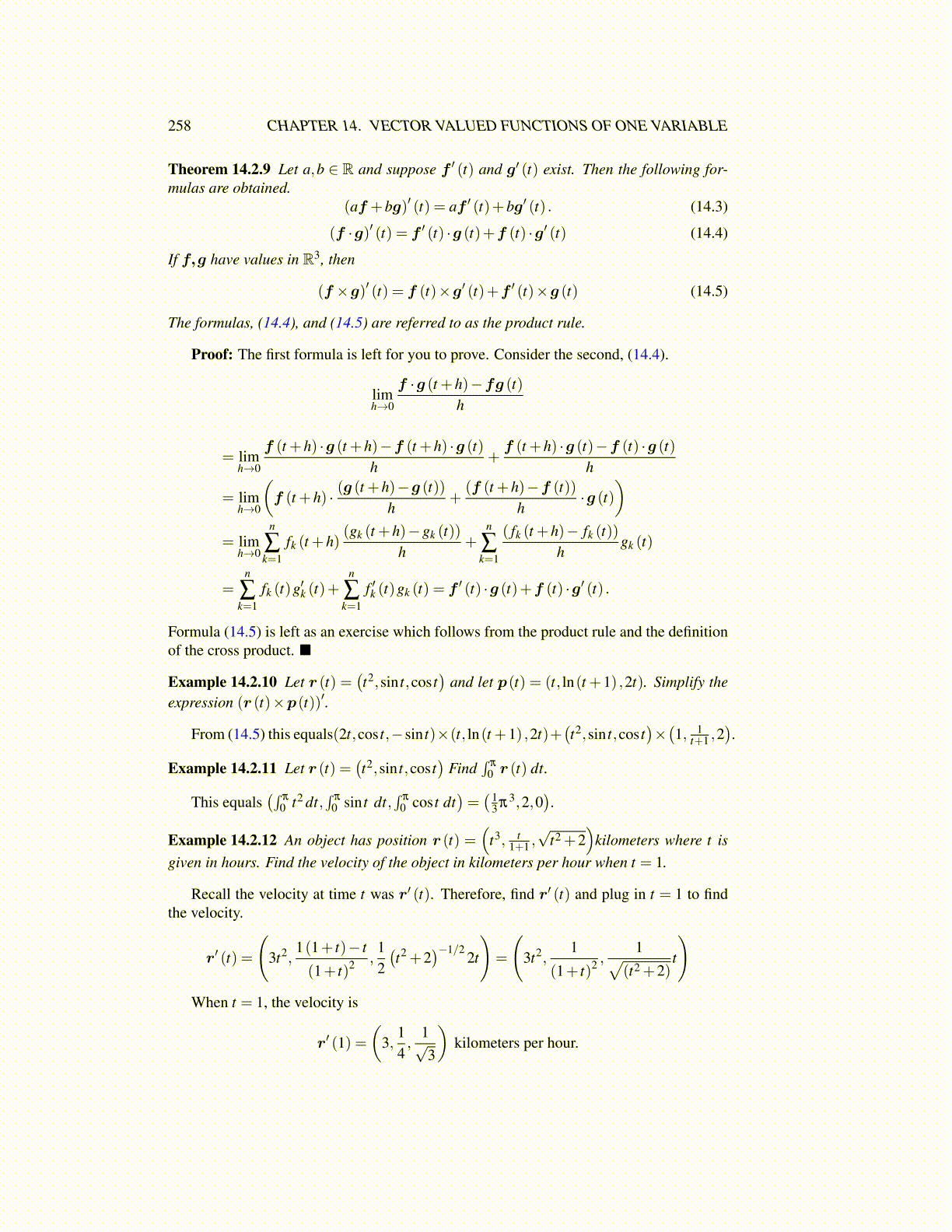
258 CHAPTER 14. VECTOR VALUED FUNCTIONS OF ONE VARIABLE
Theorem 14.2.9 Let a,b ∈ R and suppose f ′ (t) and g′ (t) exist. Then the following for-mulas are obtained.
(af +bg)′ (t) = af ′ (t)+bg′ (t) . (14.3)
(f ·g)′ (t) = f ′ (t) ·g (t)+f (t) ·g′ (t) (14.4)
If f,g have values in R3, then
(f ×g)′ (t) = f (t)×g′ (t)+f ′ (t)×g (t) (14.5)
The formulas, (14.4), and (14.5) are referred to as the product rule.
Proof: The first formula is left for you to prove. Consider the second, (14.4).
limh→0
f ·g (t +h)−fg (t)h
= limh→0
f (t +h) ·g (t +h)−f (t +h) ·g (t)h
+f (t +h) ·g (t)−f (t) ·g (t)
h
= limh→0
(f (t +h) · (g (t +h)−g (t))
h+
(f (t +h)−f (t))h
·g (t))
= limh→0
n
∑k=1
fk (t +h)(gk (t +h)−gk (t))
h+
n
∑k=1
( fk (t +h)− fk (t))h
gk (t)
=n
∑k=1
fk (t)g′k (t)+n
∑k=1
f ′k (t)gk (t) = f ′ (t) ·g (t)+f (t) ·g′ (t) .
Formula (14.5) is left as an exercise which follows from the product rule and the definitionof the cross product. ■
Example 14.2.10 Let r (t) =(t2,sin t,cos t
)and let p(t) = (t, ln(t +1) ,2t). Simplify the
expression (r (t)×p(t))′.
From (14.5) this equals(2t,cos t,−sin t)×(t, ln(t +1) ,2t)+(t2,sin t,cos t
)×(1, 1
t+1 ,2).
Example 14.2.11 Let r (t) =(t2,sin t,cos t
)Find
∫π
0 r (t) dt.
This equals(∫
π
0 t2 dt,∫
π
0 sin t dt,∫
π
0 cos t dt)=( 1
3 π3,2,0).
Example 14.2.12 An object has position r (t) =(
t3, t1+1 ,√
t2 +2)
kilometers where t isgiven in hours. Find the velocity of the object in kilometers per hour when t = 1.
Recall the velocity at time t was r′ (t). Therefore, find r′ (t) and plug in t = 1 to findthe velocity.
r′ (t) =
(3t2,
1(1+ t)− t
(1+ t)2 ,12(t2 +2
)−1/22t
)=
(3t2,
1
(1+ t)2 ,1√
(t2 +2)t
)When t = 1, the velocity is
r′ (1) =(
3,14,
1√3
)kilometers per hour.